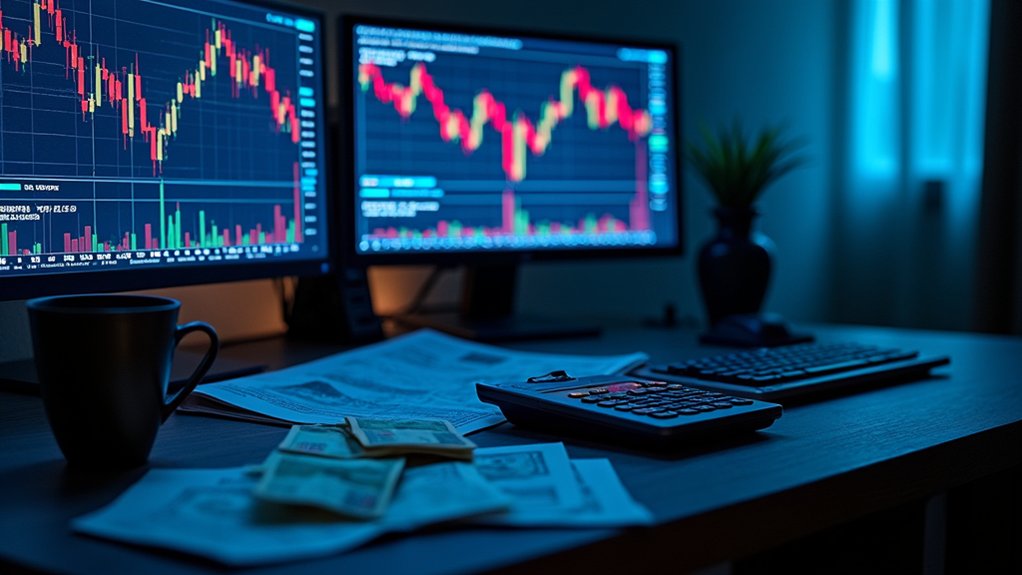Successful forex traders ditch vague “get rich” fantasies for specific numeric targets like 5% monthly returns and hard risk caps of 1-2% per trade. The SMART framework—Specific, Measurable, Achievable, Relevant, Time-bound—turns wishful thinking into trackable milestones that expose failure before accounts implode. Most beginners ignore the brutal reality that 70-80% of retail forex traders lose money, especially in markets with infrastructure challenges. Position sizing, stop-losses, and regular journal reviews separate the survivors from the wreckage. The details below break down exactly how goal-setting frameworks prevent rookie mistakes.

In the sprawling, fast-moving world of African forex trading—from the bustling dealing rooms of Johannesburg to the mobile-first traders in Lagos and Nairobi—most newcomers plunge in with dreams but no map. They chase pips like lottery tickets, convinced next week's rent will come from a lucky EUR/USD swing. Reality hits harder than a power cut during market hours.
Clear, specific goals outperform vague ambitions every single time. Not “I want to get rich,” but “5% monthly return” or “risk no more than 2% per trade.” Numbers matter. Written goals increase commitment—67% of successful businesspeople scribble theirs down, and forex traders are no exception. A Ghanaian trader targeting consistent small wins will outlast the Kenyan chasing moonshots.
The SMART framework isn't just corporate jargon. Specific, Measurable, Achievable, Relevant, Time-bound. It works for USD/ZAR pairs in Cape Town and NGN volatility in Abuja alike. Measurable means tracking profitable trades per month, not guessing. Achievable means a beginner in Kampala shouldn't aim for hedge-fund returns while still confusing support and resistance. Time-bound criteria push progress and expose failure before accounts blow up.
Honest self-assessment separates survivors from statistics. Evaluating financial situation determines risk capital—money that can vanish without threatening school fees or groceries. Understanding risk tolerance sets boundaries. Recognizing weaknesses pinpoints what to study next. Beginner traders across Accra, Dar es Salaam, or Kigali benefit from conservative, education-focused targets before attempting aggressive strategies.
A formal trading plan operationalizes those goals with entry and exit criteria, risk management rules, and review schedules. Regular updates accommodate market changes—because the Kenyan shilling behaves differently than the South African rand, and both shift when global sentiment turns. Backtesting with historical data improves reliability. Trading journals track what actually happened versus what was supposed to happen. A weekly check-in process keeps the strategy agile and prevents it from becoming obsolete in changing market conditions.
Pre-determined risk per trade, commonly 1–2%, limits potential drawdowns. Stop-loss and take-profit orders enforce discipline when emotion screams otherwise. Risk-reward ratios—often at least 1:2—set expectations for profitable strategies. Diversification across currency pairs reduces exposure to single-market shocks, whether it's Egyptian pound instability or Zambian kwacha swings. Buffer zones for sudden price swings protect accounts when volatility strikes without warning. Position sizing calculations help traders determine the exact lot size to trade based on account balance, risk percentage, and stop-loss distance, ensuring consistency across different market conditions.
Ongoing skill enhancement strengthens goal achievement capacity. Continuous self-improvement is shared by 86% of high-performers, and forex demands it. Regular performance evaluation identifies gaps. Engagement with trading communities or mentors accelerates learning. Understanding income ranges for professional forex traders helps calibrate expectations and prevents setting targets so ambitious they guarantee disappointment and reckless risk-taking. Aligning trading objectives with personal financial goals and lifestyle ensures your strategy supports broader life ambitions rather than undermining them. Successful traders maintain a daily trading journal to review performance, capture lessons, and identify patterns that separate winning streaks from costly errors. Demo accounts allow experimenting with new strategies without risking real capital, providing a safe testing ground before applying techniques to live trading. Breaking down larger trading ambitions into smaller milestones helps maintain motivation and allows for incremental adjustments as market understanding deepens.
The brutal truth? Only 20–30% of retail forex traders consistently achieve profits. Realistic goals acknowledge that statistic. They separate hope from strategy, emotion from execution. African traders steering unreliable internet, currency restrictions, and broker limitations need them most.
Common Questions
How Do Currency Restrictions in Countries Like Nigeria Affect My Trading Goals?
Currency restrictions hit Nigerian traders hard. The 2025 ISA criminalizes unregistered forex platforms, so access shrinks fast. Only SEC-approved venues are legal now. That means fewer options, higher costs, and tighter liquidity. The CBN's new FX Code piles on compliance layers—real-time monitoring, manager oversight, clearance for every transaction change. Spreads widen. Execution slows. The official naira rate and street rates split further apart. Unregistered platforms face shutdown. Goals? They'll need serious recalibration when the market itself is choking.
What Realistic Monthly Returns Should Traders in Kenya or Ghana Target?
Kenyan and Ghanaian traders should realistically eye 1–3% monthly returns if they want to stay in the game long-term. Markets here are less liquid, more volatile, and regulation is patchy at best. Kenya's Capital Markets Authority doesn't even track retail performance data.
Sure, Ghana's Cedi bounced 32% recently, but that knife cuts both ways. Chasing 5%+ monthly? That's asking for trouble in these conditions. Capital preservation beats get-rich-quick fantasies every time.
Should I Set Goals in USD or My Local Currency Like Naira?
Most African traders should track both. Here's why: Broker accounts run in USD, so that's where profit calculations live.
But living in Lagos or Accra? Bills come in naira or cedis. A Kenyan trader making $200 monthly looks great until the shilling tanks 15% and purchasing power evaporates. Track USD for trading performance, local currency for actual wealth. It's double work, sure. But currency conversion isn't just math—it's economic reality across the continent.
How Does Unstable Electricity in My Country Impact Achieving Trading Targets?
Unstable electricity across Nigeria, Kenya, Ghana, and much of Africa regularly kicks traders offline during critical moments.
MT4 freezes mid-trade. Expert Advisors stop running. Positions go unmonitored. A power cut during volatile hours means missed entries, unmanaged stops, or margin calls hitting while the screen's black.
VPS hosting sidesteps local grid failures entirely. Backup internet and generators help, but cost money.
Without reliable power, hitting consistent targets becomes a coin flip, not a strategy.
Can I Realistically Trade Full-Time With Capital Under $500 in Africa?
Trading full-time on under $500 in Africa? Not realistic. Even hitting a strong 10% monthly return yields just $50—before costs, taxes, and the broker's cut. That's nowhere near living expenses.
Most brokers let you open accounts with $10 to $100, sure, but small capital gets crushed by margin calls and spreads. Industry data shows 70–90% of new traders blow their accounts within a year, especially at this size. It's a learning fund, not a salary.










